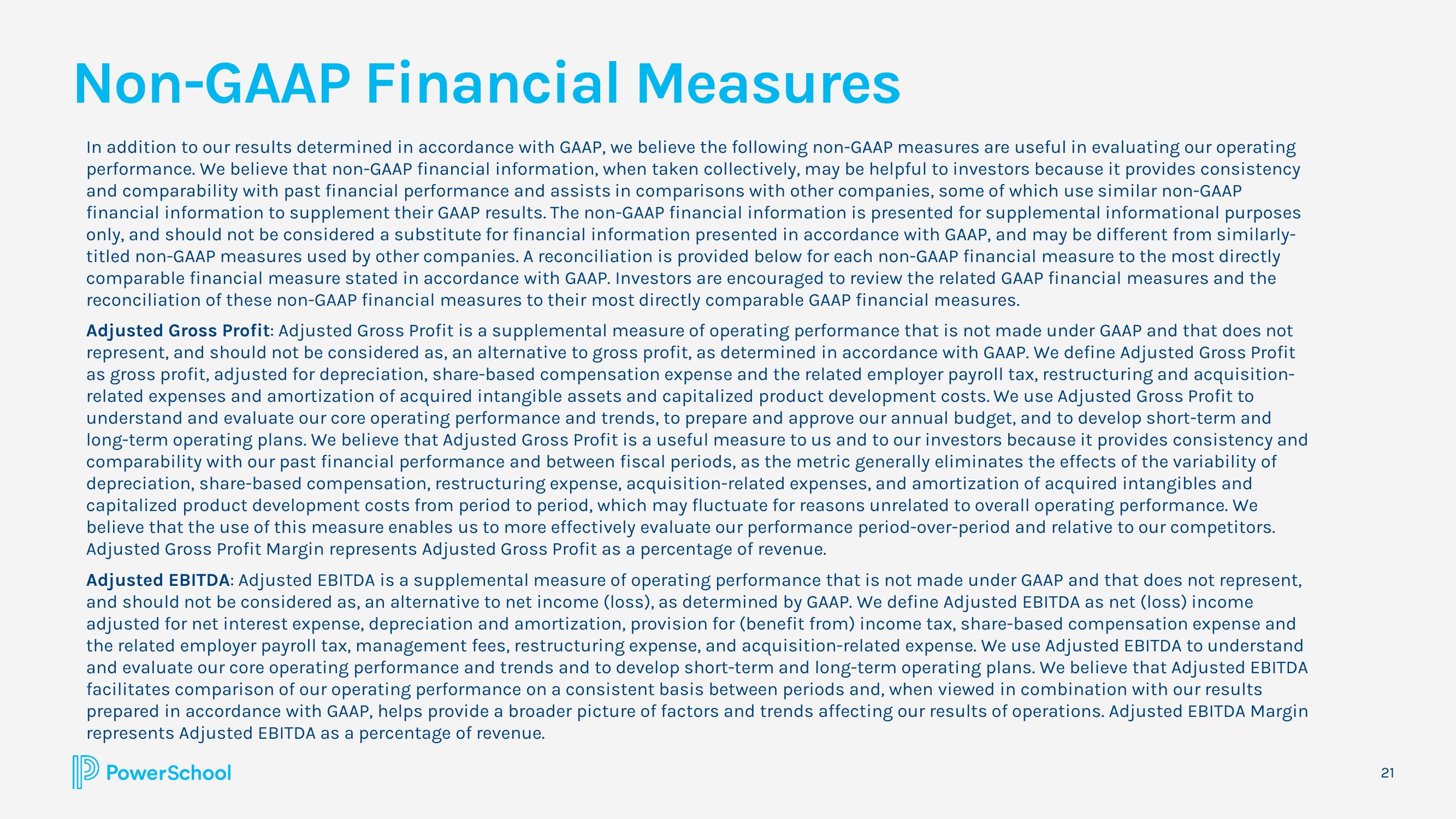PowerSchool Results Presentation Deck
Non-GAAP Financial Measures
In addition to our results determined in accordance with GAAP, we believe the following non-GAAP measures are useful in evaluating our operating
performance. We believe that non-GAAP financial information, when taken collectively, may be helpful to investors because it provides consistency
and comparability with past financial performance and assists in comparisons with other companies, some of which use similar non-GAAP
financial information to supplement their GAAP results. The non-GAAP financial information is presented for supplemental informational purposes
only, and should not be considered a substitute for financial information presented in accordance with GAAP, and may be different from similarly-
titled non-GAAP measures used by other companies. A reconciliation is provided below for each non-GAAP financial measure to the most directly
comparable financial measure stated in accordance with GAAP. Investors are encouraged to review the related GAAP financial measures and the
reconciliation of these non-GAAP financial measures to their most directly comparable GAAP financial measures.
Adjusted Gross Profit: Adjusted Gross Profit is a supplemental measure of operating performance that is not made under GAAP and that does not
represent, and should not be considered as, an alternative to gross profit, as determined in accordance with GAAP. We define Adjusted Gross Profit
as gross profit, adjusted for depreciation, share-based compensation expense and the related employer payroll tax, restructuring and acquisition-
related expenses and amortization of acquired intangible assets and capitalized product development costs. We use Adjusted Gross Profit to
understand and evaluate our core operating performance and trends, to prepare and approve our annual budget, and to develop short-term and
long-term operating plans. We believe that Adjusted Gross Profit is a useful measure to us and to our investors because it provides consistency and
comparability with our past financial performance and between fiscal periods, as the metric generally eliminates the effects of the variability of
depreciation, share-based compensation, restructuring expense, acquisition-related expenses, and amortization of acquired intangibles and
capitalized product development costs from period to period, which may fluctuate for reasons unrelated to overall operating performance. We
believe that the use of this measure enables us to more effectively evaluate our performance period-over-period and relative to our competitors.
Adjusted Gross Profit Margin represents Adjusted Gross Profit as a percentage of revenue.
Adjusted EBITDA: Adjusted EBITDA is a supplemental measure of operating performance that is not made under GAAP and that does not represent,
and should not be considered as, an alternative to net income (loss), as determined by GAAP. We define Adjusted EBITDA as net (loss) income
adjusted for net interest expense, depreciation and amortization, provision for (benefit from) income tax, share-based compensation expense and
the related employer payroll tax, management fees, restructuring expense, and acquisition-related expense. We use Adjusted EBITDA to understand
and evaluate our core operating performance and trends and to develop short-term and long-term operating plans. We believe that Adjusted EBITDA
facilitates comparison of our operating performance on a consistent basis between periods and, when viewed in combination with our results
prepared in accordance with GAAP, helps provide a broader picture of factors and trends affecting our results of operations. Adjusted EBITDA Margin
represents Adjusted EBITDA as a percentage of revenue.
PowerSchool
21View entire presentation